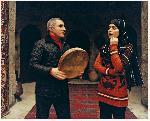 |
Central Asia is home to a wealth of classical, folk and popular musical traditions. Notwithstanding its immensely rich cultural heritage, this region remains one of the least known in the world. In the broadest sense, Central Asia – a term often indiscriminately conflated with such geopolitical concepts as "Inner Asia," "Turkestan," and the "Silk Road/Route"– comprises the vast territory situated between Turkey to the west and China proper to the east, and between Russia to the north and India and Pakistan to the south. It normally includes the five former Soviet republics – or the five "stans": Kazakhstan, Uzbekistan, Tajikistan, Turkmenistan, and Kyrgyzstan – plus the Lower Caucasus (Azerbaijan, for example), Xinjiang Uyghur Autonomous Region in China, and sometimes certain parts of Iran, Afghanistan, Mongolia and Tuva.
While Central Asia is unified by a number of important shared cultural processes – Turkic–speaking (except for Tajik, which is a Persian language), the Islamic faith, a Soviet legacy and the post–socialist present, to name but a few – this enormous region and its peoples also brought to the world one of its most diverse and heterogeneous musical traditions. It ranges from the multiplicity of nomadic and folk genres of the Kazakh and Kyrgyz to the revered courtly repertoires of the Azeri, Tajik, Uyghur, and Uzbek. Influences from Arab, Turkish, Persian, Russian, Mongol, and Chinese music are abundant and salient, making Central Asia a crossroads of the world's civilizations. Among the rich musical traditions in Central Asia, the art of maqām remains the most refined and elevated. The term maqām is used among Central Asian musicians to refer not only to the melodic mode (as used in Arab and Turkish classical music) but also to the musical suite and the classical genre itself. The most well–known Central Asian maqām genres are the Uzbek–Tajik shashmaqām (literally, "six maqām") from the sixteenth–century Bukharan Emirs' court, the Uyghur on ikki muqam (literally, "twelve maqām") from the sixteenth–century Yarkand Khanate, and the muğam of Azerbaijan.
Not unlike the other two Central Asian maqām genres, the art of Azeri muğam combines vocal music, instrumental music and dance in musical suites. Each suite is identified by a primary melodic mode called maqām, referring to a set of pitches used as a scale in the music (and sometimes as its emotional content). Influences from Persian music on Azeri musical instruments are noticeable. A typical ensemble of Azeri muğam comprises such instruments as: the tār, a long–necked plucked lute with a double–bowl shaped, resonating body, adapted from the Iranian tār during the late nineteenth century; the kamancheh, a spike fiddle also widely found in Persian and Armenian music; and the daf, a circular framed drum – ubiquitous in Central Asia, known as doira by the Uzbek and as dap by the Uyghur – used to articulate metrical cycles. To many listeners, inside and outside Azerbaijan, the undisputed master of the Azeri muğam is the famous Alim Qasimov (b.1957) who has performed widely throughout the world since the late 1980s, becoming an indispensable icon of Azeri music, if not simply of Azerbaijan. His performances are frequently marked by elaborate vocal ornaments conveyed through theatrical improvisational techniques that enhance the compelling emotional power of the music.
Nomadic traditions from the Kazakh and Kyrgyz steppes exhibit a sharp contrast with the urban classical maqām traditions discussed above. A central aspect of the nomadic musical traditions in Central Asia is the close connection between music and story–telling. Narrative genres, such as literary epics and sung poems, have been crucial in maintaining performing and poetic traditions through oral transmission. The well–known Kyrgyz national epic, Manas – named after its central warrior hero – is but one notable example. Believed to the longest epic poem in the world, Manas consists of half a million poetic lines and remains an important source for the study of Central Asian societies, cultures, and histories.
The narrative potential of music in this Central Asian bard tradition is also realized in an instrumental genre known as kui (literally, "mood"), which contains programmatic pieces considered to be the instrumental equivalents of sung narrative epics. Plucked lutes remain the most important musical instruments for accompanying vocal epics and for performing solo repertoires. The komuz, arguably the most popular Kyrgyz musical instrument, is a fretless, long–necked, three–string lute played with extremely elaborate plucking and strumming techniques. The Kazakh counterpart of the Kyrgyz komuz is the fretted, two–string dombra, a familiar musical instrument to many Chinese listeners as a cultural icon for the Kazakh minority in northwest China. Equally powerful and versatile in their narrative capacity are the two–string bowed fiddles, known respectively as the kobyz and the kyl kyak in Kazakh and Kyrgyz music. Both are used extensively to imitate a variety of sounds in telling stories. The rich, resonant sonority of the kobyz and the kyl kyak often remind listeners of the guttural and somewhat throaty vocal timbre that is at the root of much of the nomadic musical traditions in Central Asia.
Similar to other traditional arts in Central Asia, music did not survive the Soviet era intact. Under the Soviet ideology of socialist realism – and the modernist reformism it entailed – much of the traditional music was transformed, often in the names of progress and development, to better serve the socialist agenda. Traditional musical instruments and ensemble settings, as well as musical styles and aesthetics, were deemed inadequate and modified accordingly to the model of nineteenth–century European classical music – roughly exemplified by such practices as functional harmonic progression, standardized Western scales, large–scale instrumental orchestras and professional music conservatories. The Kazakh State Kurmangazy Orchestra, created in 1934, represents the most ambitious of such Soviet musical projects.
The post–Soviet era witnessed various attempts to return to the traditional and, arguably, authentic forms. Among the most prominent voices of traditional Kyrgyz music today is Tengir–Too, an instrumental and vocal ensemble based in Bishkek, the capital of Kyrgyzstan. It has performed around the world using a wide range of Central Asian nomadic traditions. Another prominent group in the global circuit of Central Asian music is the Bardic Divas, an all–female ensemble that performs a variety of both traditionally male and female genres from Kazakhstan, Kyrgyzstan, and the Khorezm region in west Uzbekistan.
本網站內一切內容之版權均屬國際演藝評論家協會(香港分會)及原作者所有,未經本會及/或原作者書面同意,不得轉載。









